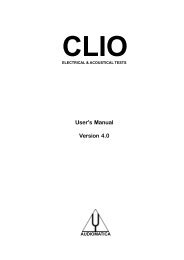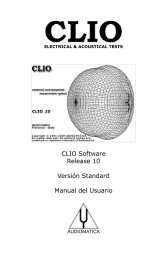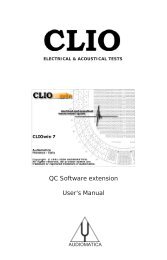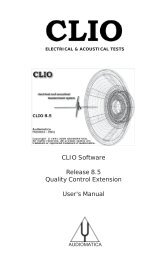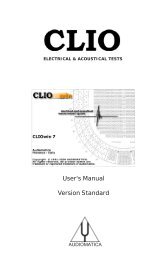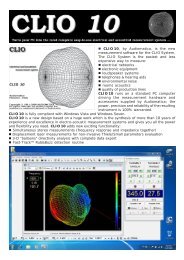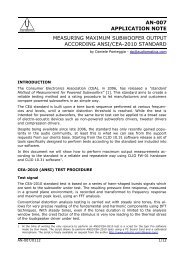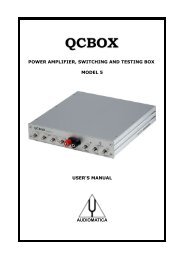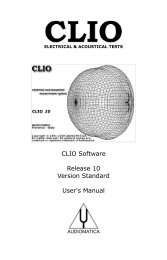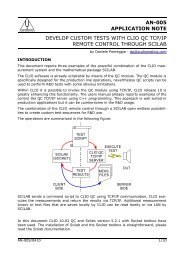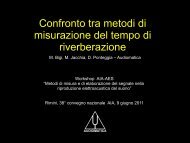CLIOwin 6.5 PCI User's Manual - Audiomatica Srl
CLIOwin 6.5 PCI User's Manual - Audiomatica Srl
CLIOwin 6.5 PCI User's Manual - Audiomatica Srl
You also want an ePaper? Increase the reach of your titles
YUMPU automatically turns print PDFs into web optimized ePapers that Google loves.
8.2.1 TOOLBAR BUTTONS<br />
Starts the measurement.<br />
Permits execution with the control panel in a minimized state. Only a small stay-onthe-top<br />
display remains visible. See 8.3.2.<br />
Stops the measurement.<br />
If pressed displays all measured parameters.<br />
Captures the actual reading of the multi-meter as the global reference level (or<br />
microphone sensitivity); refer to 8.3.3 and 8.5.1 for details.<br />
Control the scale of the meter bar graph.<br />
Enables/disables the generator control toolbar (see 8.3.1); this setting is saved<br />
within <strong>CLIOwin</strong> global settings.<br />
8.2.2 TOOLBAR DROP DOWN LISTS<br />
parameter<br />
Selects the parameter to be measured.<br />
unit<br />
Selects the measurement unit.<br />
channel<br />
Selects the input channel.<br />
integration<br />
Selects between fast (125ms) and slow (1s) integration. Not applicable to the LCR<br />
meter.<br />
8.3 USING THE MULTI-METER<br />
The first application of the Multi-meter has been described in section 3.4.1 when<br />
<strong>CLIOwin</strong> was started for the first time. This was a simple generation of a 1kHz sinusoid<br />
(0dBu output level) and relative level capture with the Multi-meter. You can continue<br />
the measurement described to familiarize better with the instrument. Pressing the<br />
magnifier will let you inspect all the parameters that the Multi-meter measures in<br />
parallel (Fig.8.1); changing the selected parameter will bring it in foreground; for any<br />
parameter it is possible to choose different units, for example THD can be shown in<br />
percentage or in dB; then you can select the input channel and the integration. This last<br />
parameter (integration) affects the measurement rate, since the integration fast<br />
assumes 125ms of exponential averaging while the integration slow assumes 1s of<br />
exponential averaging. The program approximates these constants trying to measure<br />
the computer speed and varying the number of averages calculated.<br />
The rest of the paragraph deals with other applications of the Multi-meter.<br />
8.3.1 CONTROLLING THE GENERATOR<br />
It is possible to control the generator by means of the dedicated main toolbar button<br />
70 Chapter 8 - Multi-Meter



